Needs Assessment Report: Stakeholder Analysis in Dementia Care
VerifiedAdded on 2022/08/29
|10
|2403
|20
Report
AI Summary
This report provides a comprehensive needs assessment of dementia patients in Australia, focusing on stakeholder analysis and the effectiveness of interventions. It examines the prevalence of dementia, the affected population, and the various types of dementia, including Alzheimer's disease and vascular dementia. The report identifies key stakeholders such as healthcare providers, government organizations, and support groups, detailing their roles, interests, and influence in addressing the issue. It analyzes social, environmental, and behavioral determinants of dementia and evaluates the efficiency and effectiveness of programs like the Specialist Dementia Care Program and initiatives by Dementia Australia. The report also highlights clinical practice guidelines and national frameworks aimed at improving dementia care, with specific attention to the needs of Aboriginal and Torres Strait Islander populations. The conclusion emphasizes the need for education, treatment, health assistance, and collaborative care to prevent and manage dementia effectively.

Running Head: Needs Assessment
Needs Assessment of the stakeholder
Name of the Student
Name of the University
Authors Note
Needs Assessment of the stakeholder
Name of the Student
Name of the University
Authors Note
Paraphrase This Document
Need a fresh take? Get an instant paraphrase of this document with our AI Paraphraser

1Needs Assessment of the stakeholder
Introduction
Dementia is one of the most significant problems among the aged population of
Australia. According to a report, almost 400000 people are suffering from this disease.
Dementia is the second leading health condition for the death of women in the Australian
context. This condition can be observed in 1 out of 10 people in Australia. Dementia is
caused by a different variety of illnesses and injuries of the brain. Memory, thinking capacity,
language, judgment, and behaviors of a person are affected by this disease. The dementia is
ranged from mild to severe range. The disease is responsible for different other mental
illnesses and disorders such as Alzheimer's disease, dementia with Lewy bodies, vascular
dementia, frontotemporal dementia, and mixed dementia. The stakeholders should aim at the
needs assessment, planning, facilitation, and coordination. This essay will focus on the
population of the dementia patients in Australia and the effectiveness of interventions taken
by the stakeholders to prevent the impact of dementia on the target population.
Discussion
Population
According to a report, 354000 people were affected until 2016. The statistic has
shown that approximately 40% of the affected population has been increased from
2006(www.aihw.gov.au. ,2020). According to the report, 74% of females are suffered from
dementia, whereas 65% of older people (who are aged more than 65 years) have dementia.
On the contrary, only 65% of the affected population get care provision for more than 40
hours per week. 60% of the carer who support dementia patients are working for less than
five years. As per the report of Dementia Australia, 459,000 Australians will have dementia
in 2020, and the number can be increased to 590,000 by 2028
(agedcare.royalcommission.gov.au. ,2020). The situation is predicted as worse as the number
Introduction
Dementia is one of the most significant problems among the aged population of
Australia. According to a report, almost 400000 people are suffering from this disease.
Dementia is the second leading health condition for the death of women in the Australian
context. This condition can be observed in 1 out of 10 people in Australia. Dementia is
caused by a different variety of illnesses and injuries of the brain. Memory, thinking capacity,
language, judgment, and behaviors of a person are affected by this disease. The dementia is
ranged from mild to severe range. The disease is responsible for different other mental
illnesses and disorders such as Alzheimer's disease, dementia with Lewy bodies, vascular
dementia, frontotemporal dementia, and mixed dementia. The stakeholders should aim at the
needs assessment, planning, facilitation, and coordination. This essay will focus on the
population of the dementia patients in Australia and the effectiveness of interventions taken
by the stakeholders to prevent the impact of dementia on the target population.
Discussion
Population
According to a report, 354000 people were affected until 2016. The statistic has
shown that approximately 40% of the affected population has been increased from
2006(www.aihw.gov.au. ,2020). According to the report, 74% of females are suffered from
dementia, whereas 65% of older people (who are aged more than 65 years) have dementia.
On the contrary, only 65% of the affected population get care provision for more than 40
hours per week. 60% of the carer who support dementia patients are working for less than
five years. As per the report of Dementia Australia, 459,000 Australians will have dementia
in 2020, and the number can be increased to 590,000 by 2028
(agedcare.royalcommission.gov.au. ,2020). The situation is predicted as worse as the number
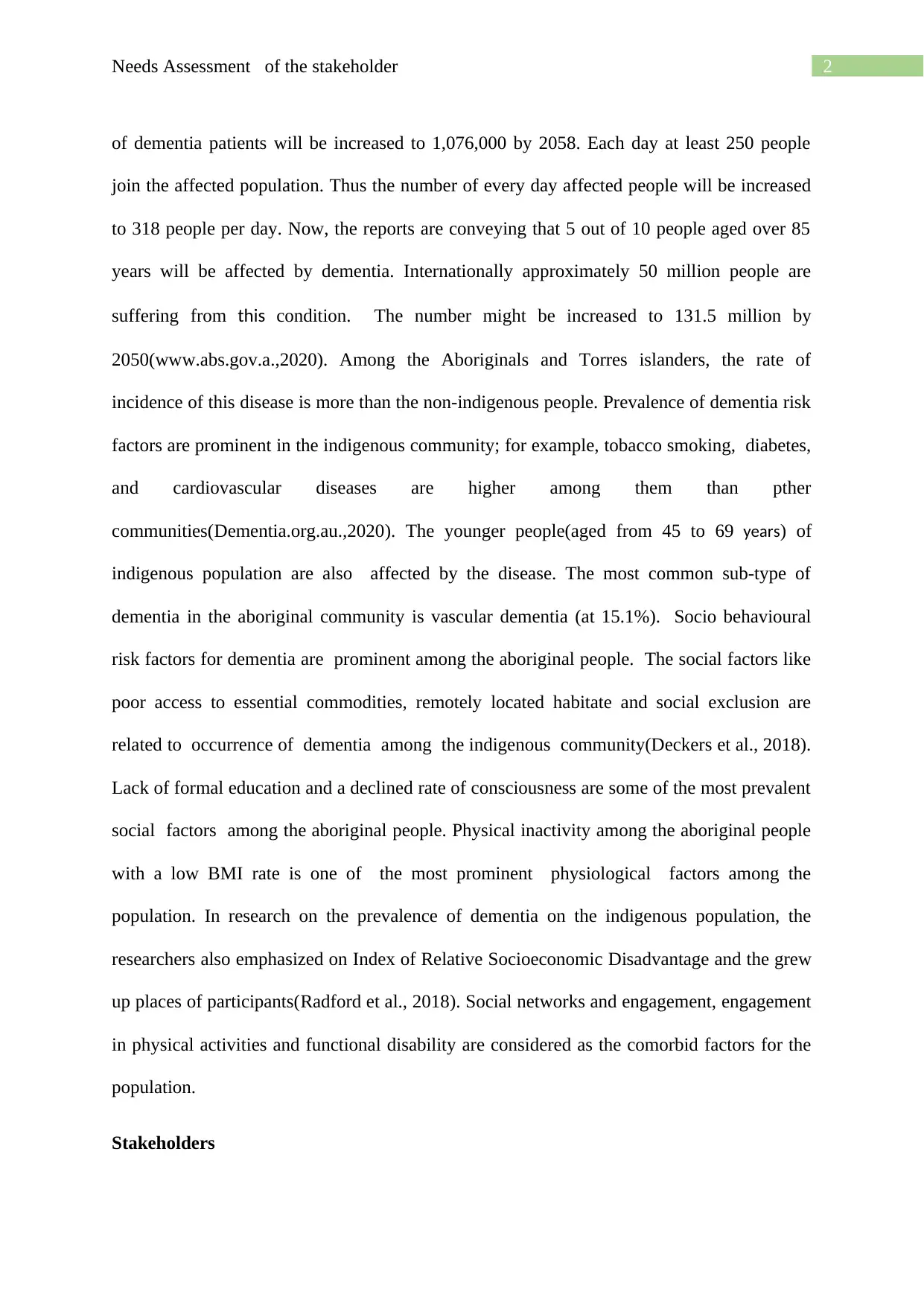
2Needs Assessment of the stakeholder
of dementia patients will be increased to 1,076,000 by 2058. Each day at least 250 people
join the affected population. Thus the number of every day affected people will be increased
to 318 people per day. Now, the reports are conveying that 5 out of 10 people aged over 85
years will be affected by dementia. Internationally approximately 50 million people are
suffering from this condition. The number might be increased to 131.5 million by
2050(www.abs.gov.a.,2020). Among the Aboriginals and Torres islanders, the rate of
incidence of this disease is more than the non-indigenous people. Prevalence of dementia risk
factors are prominent in the indigenous community; for example, tobacco smoking, diabetes,
and cardiovascular diseases are higher among them than pther
communities(Dementia.org.au.,2020). The younger people(aged from 45 to 69 years) of
indigenous population are also affected by the disease. The most common sub-type of
dementia in the aboriginal community is vascular dementia (at 15.1%). Socio behavioural
risk factors for dementia are prominent among the aboriginal people. The social factors like
poor access to essential commodities, remotely located habitate and social exclusion are
related to occurrence of dementia among the indigenous community(Deckers et al., 2018).
Lack of formal education and a declined rate of consciousness are some of the most prevalent
social factors among the aboriginal people. Physical inactivity among the aboriginal people
with a low BMI rate is one of the most prominent physiological factors among the
population. In research on the prevalence of dementia on the indigenous population, the
researchers also emphasized on Index of Relative Socioeconomic Disadvantage and the grew
up places of participants(Radford et al., 2018). Social networks and engagement, engagement
in physical activities and functional disability are considered as the comorbid factors for the
population.
Stakeholders
of dementia patients will be increased to 1,076,000 by 2058. Each day at least 250 people
join the affected population. Thus the number of every day affected people will be increased
to 318 people per day. Now, the reports are conveying that 5 out of 10 people aged over 85
years will be affected by dementia. Internationally approximately 50 million people are
suffering from this condition. The number might be increased to 131.5 million by
2050(www.abs.gov.a.,2020). Among the Aboriginals and Torres islanders, the rate of
incidence of this disease is more than the non-indigenous people. Prevalence of dementia risk
factors are prominent in the indigenous community; for example, tobacco smoking, diabetes,
and cardiovascular diseases are higher among them than pther
communities(Dementia.org.au.,2020). The younger people(aged from 45 to 69 years) of
indigenous population are also affected by the disease. The most common sub-type of
dementia in the aboriginal community is vascular dementia (at 15.1%). Socio behavioural
risk factors for dementia are prominent among the aboriginal people. The social factors like
poor access to essential commodities, remotely located habitate and social exclusion are
related to occurrence of dementia among the indigenous community(Deckers et al., 2018).
Lack of formal education and a declined rate of consciousness are some of the most prevalent
social factors among the aboriginal people. Physical inactivity among the aboriginal people
with a low BMI rate is one of the most prominent physiological factors among the
population. In research on the prevalence of dementia on the indigenous population, the
researchers also emphasized on Index of Relative Socioeconomic Disadvantage and the grew
up places of participants(Radford et al., 2018). Social networks and engagement, engagement
in physical activities and functional disability are considered as the comorbid factors for the
population.
Stakeholders
⊘ This is a preview!⊘
Do you want full access?
Subscribe today to unlock all pages.

Trusted by 1+ million students worldwide

3Needs Assessment of the stakeholder
Workforce availability
Stakeholders for preventing dementia across the country involves different
professionals and institutions along with the patient and the family members. Hospitals,
research centers, respite care centers, Government organisations and NGOs with the
sponsors are the stakeholders for preventing dementia . For person-centered treatments, the
stakeholders are nurses, health care support workers, doctors, psychologists or
psychotherapists , mental health support workers, medical attendants (might be enrolled
nurses or assistant in nursing or only healthcare support workers). Physical therapists and
social workers may involve as the stake holders with the family members of the patient
in person-centered practice. The objective of a nurse and other healthcare workers is to find
needs of the patients to treat them efficiently. Similarly, to understand the risk and comorbid
factors for any disorder among a specific population , the stakeholders are required to
understand different needs for the affected population.
Analysis of service needs:
Social, environmental, and behavioural health determinants needs Assessment
Dementia supportive programs require to focus on the different sectors such as
social, environmental, and behavioral. The social determinants are related to the availability
of workforce, resources, and practical approach towards the issues related to dementia. Air
quality passive tobacco smoking, toxic heavy metals are the environmental factors for
Alzheimer's dementia. Occupation related exposures of aluminum lead radiation and
fumigation are responsible for dementia according to a report (Killin, Starr, Shiue & Russ,
2016). There are other miscellaneous environmental factors such as low and extremely low
Workforce availability
Stakeholders for preventing dementia across the country involves different
professionals and institutions along with the patient and the family members. Hospitals,
research centers, respite care centers, Government organisations and NGOs with the
sponsors are the stakeholders for preventing dementia . For person-centered treatments, the
stakeholders are nurses, health care support workers, doctors, psychologists or
psychotherapists , mental health support workers, medical attendants (might be enrolled
nurses or assistant in nursing or only healthcare support workers). Physical therapists and
social workers may involve as the stake holders with the family members of the patient
in person-centered practice. The objective of a nurse and other healthcare workers is to find
needs of the patients to treat them efficiently. Similarly, to understand the risk and comorbid
factors for any disorder among a specific population , the stakeholders are required to
understand different needs for the affected population.
Analysis of service needs:
Social, environmental, and behavioural health determinants needs Assessment
Dementia supportive programs require to focus on the different sectors such as
social, environmental, and behavioral. The social determinants are related to the availability
of workforce, resources, and practical approach towards the issues related to dementia. Air
quality passive tobacco smoking, toxic heavy metals are the environmental factors for
Alzheimer's dementia. Occupation related exposures of aluminum lead radiation and
fumigation are responsible for dementia according to a report (Killin, Starr, Shiue & Russ,
2016). There are other miscellaneous environmental factors such as low and extremely low
Paraphrase This Document
Need a fresh take? Get an instant paraphrase of this document with our AI Paraphraser
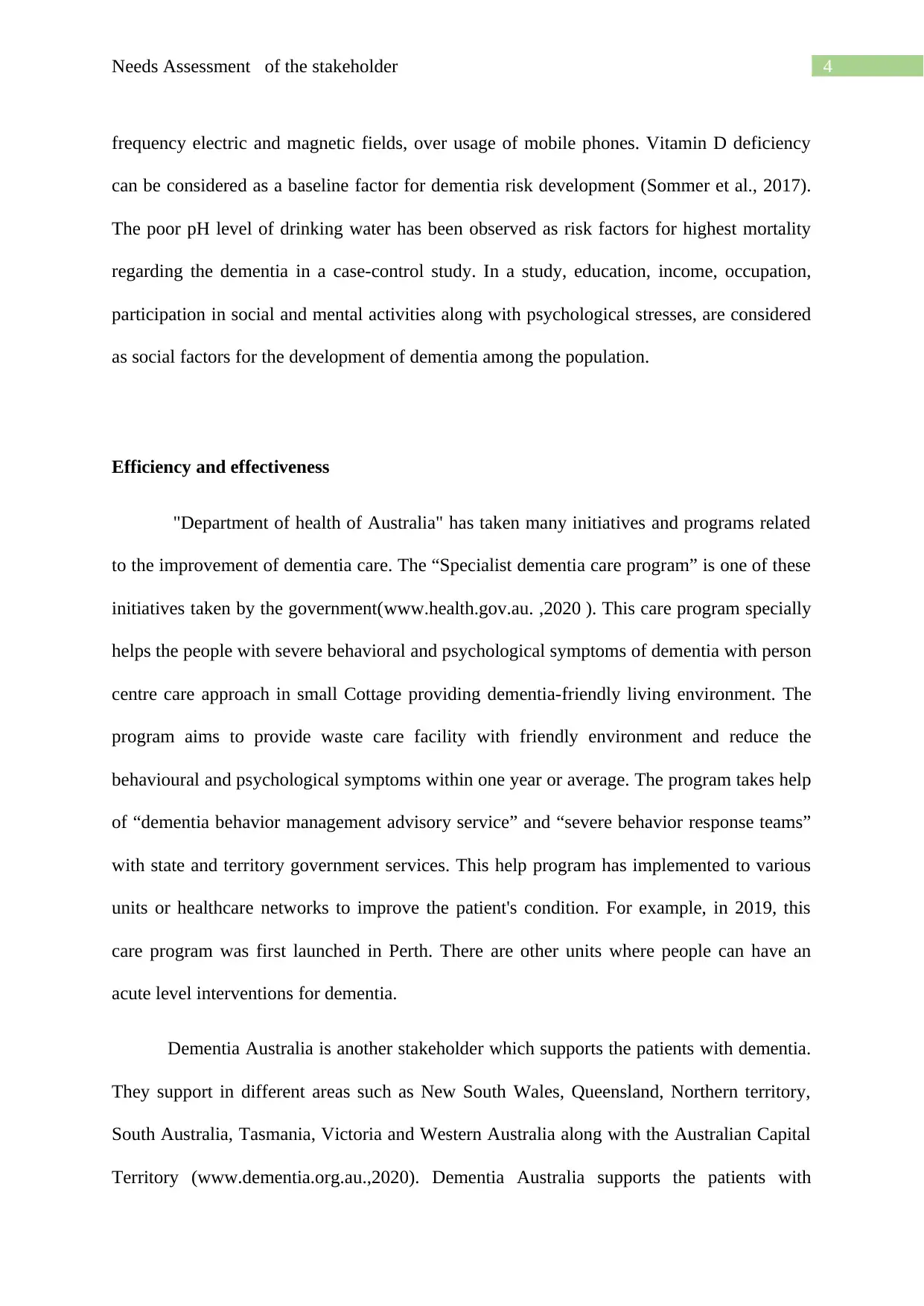
4Needs Assessment of the stakeholder
frequency electric and magnetic fields, over usage of mobile phones. Vitamin D deficiency
can be considered as a baseline factor for dementia risk development (Sommer et al., 2017).
The poor pH level of drinking water has been observed as risk factors for highest mortality
regarding the dementia in a case-control study. In a study, education, income, occupation,
participation in social and mental activities along with psychological stresses, are considered
as social factors for the development of dementia among the population.
Efficiency and effectiveness
"Department of health of Australia" has taken many initiatives and programs related
to the improvement of dementia care. The “Specialist dementia care program” is one of these
initiatives taken by the government(www.health.gov.au. ,2020 ). This care program specially
helps the people with severe behavioral and psychological symptoms of dementia with person
centre care approach in small Cottage providing dementia-friendly living environment. The
program aims to provide waste care facility with friendly environment and reduce the
behavioural and psychological symptoms within one year or average. The program takes help
of “dementia behavior management advisory service” and “severe behavior response teams”
with state and territory government services. This help program has implemented to various
units or healthcare networks to improve the patient's condition. For example, in 2019, this
care program was first launched in Perth. There are other units where people can have an
acute level interventions for dementia.
Dementia Australia is another stakeholder which supports the patients with dementia.
They support in different areas such as New South Wales, Queensland, Northern territory,
South Australia, Tasmania, Victoria and Western Australia along with the Australian Capital
Territory (www.dementia.org.au.,2020). Dementia Australia supports the patients with
frequency electric and magnetic fields, over usage of mobile phones. Vitamin D deficiency
can be considered as a baseline factor for dementia risk development (Sommer et al., 2017).
The poor pH level of drinking water has been observed as risk factors for highest mortality
regarding the dementia in a case-control study. In a study, education, income, occupation,
participation in social and mental activities along with psychological stresses, are considered
as social factors for the development of dementia among the population.
Efficiency and effectiveness
"Department of health of Australia" has taken many initiatives and programs related
to the improvement of dementia care. The “Specialist dementia care program” is one of these
initiatives taken by the government(www.health.gov.au. ,2020 ). This care program specially
helps the people with severe behavioral and psychological symptoms of dementia with person
centre care approach in small Cottage providing dementia-friendly living environment. The
program aims to provide waste care facility with friendly environment and reduce the
behavioural and psychological symptoms within one year or average. The program takes help
of “dementia behavior management advisory service” and “severe behavior response teams”
with state and territory government services. This help program has implemented to various
units or healthcare networks to improve the patient's condition. For example, in 2019, this
care program was first launched in Perth. There are other units where people can have an
acute level interventions for dementia.
Dementia Australia is another stakeholder which supports the patients with dementia.
They support in different areas such as New South Wales, Queensland, Northern territory,
South Australia, Tasmania, Victoria and Western Australia along with the Australian Capital
Territory (www.dementia.org.au.,2020). Dementia Australia supports the patients with
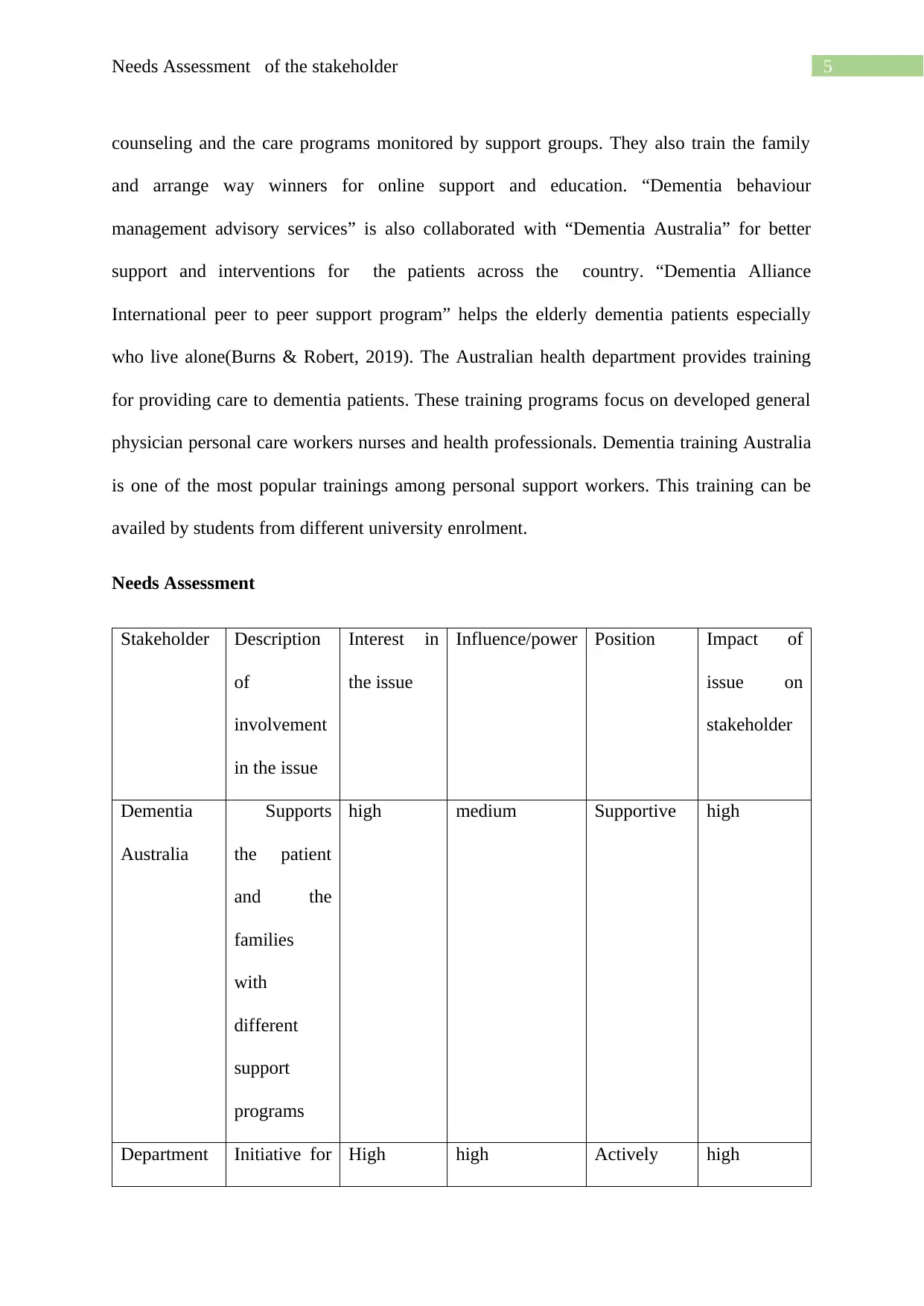
5Needs Assessment of the stakeholder
counseling and the care programs monitored by support groups. They also train the family
and arrange way winners for online support and education. “Dementia behaviour
management advisory services” is also collaborated with “Dementia Australia” for better
support and interventions for the patients across the country. “Dementia Alliance
International peer to peer support program” helps the elderly dementia patients especially
who live alone(Burns & Robert, 2019). The Australian health department provides training
for providing care to dementia patients. These training programs focus on developed general
physician personal care workers nurses and health professionals. Dementia training Australia
is one of the most popular trainings among personal support workers. This training can be
availed by students from different university enrolment.
Needs Assessment
Stakeholder Description
of
involvement
in the issue
Interest in
the issue
Influence/power Position Impact of
issue on
stakeholder
Dementia
Australia
Supports
the patient
and the
families
with
different
support
programs
high medium Supportive high
Department Initiative for High high Actively high
counseling and the care programs monitored by support groups. They also train the family
and arrange way winners for online support and education. “Dementia behaviour
management advisory services” is also collaborated with “Dementia Australia” for better
support and interventions for the patients across the country. “Dementia Alliance
International peer to peer support program” helps the elderly dementia patients especially
who live alone(Burns & Robert, 2019). The Australian health department provides training
for providing care to dementia patients. These training programs focus on developed general
physician personal care workers nurses and health professionals. Dementia training Australia
is one of the most popular trainings among personal support workers. This training can be
availed by students from different university enrolment.
Needs Assessment
Stakeholder Description
of
involvement
in the issue
Interest in
the issue
Influence/power Position Impact of
issue on
stakeholder
Dementia
Australia
Supports
the patient
and the
families
with
different
support
programs
high medium Supportive high
Department Initiative for High high Actively high
⊘ This is a preview!⊘
Do you want full access?
Subscribe today to unlock all pages.

Trusted by 1+ million students worldwide
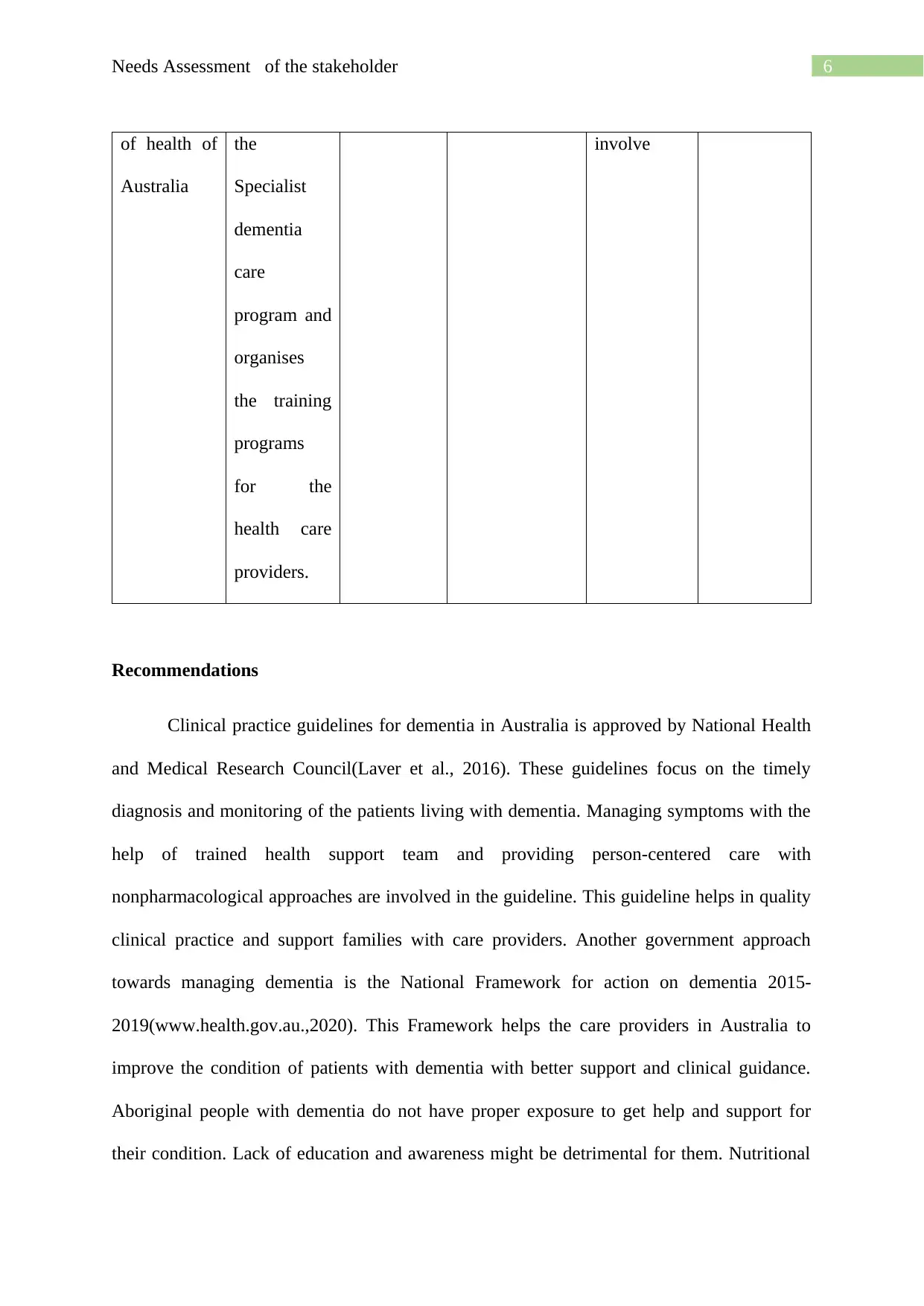
6Needs Assessment of the stakeholder
of health of
Australia
the
Specialist
dementia
care
program and
organises
the training
programs
for the
health care
providers.
involve
Recommendations
Clinical practice guidelines for dementia in Australia is approved by National Health
and Medical Research Council(Laver et al., 2016). These guidelines focus on the timely
diagnosis and monitoring of the patients living with dementia. Managing symptoms with the
help of trained health support team and providing person-centered care with
nonpharmacological approaches are involved in the guideline. This guideline helps in quality
clinical practice and support families with care providers. Another government approach
towards managing dementia is the National Framework for action on dementia 2015-
2019(www.health.gov.au.,2020). This Framework helps the care providers in Australia to
improve the condition of patients with dementia with better support and clinical guidance.
Aboriginal people with dementia do not have proper exposure to get help and support for
their condition. Lack of education and awareness might be detrimental for them. Nutritional
of health of
Australia
the
Specialist
dementia
care
program and
organises
the training
programs
for the
health care
providers.
involve
Recommendations
Clinical practice guidelines for dementia in Australia is approved by National Health
and Medical Research Council(Laver et al., 2016). These guidelines focus on the timely
diagnosis and monitoring of the patients living with dementia. Managing symptoms with the
help of trained health support team and providing person-centered care with
nonpharmacological approaches are involved in the guideline. This guideline helps in quality
clinical practice and support families with care providers. Another government approach
towards managing dementia is the National Framework for action on dementia 2015-
2019(www.health.gov.au.,2020). This Framework helps the care providers in Australia to
improve the condition of patients with dementia with better support and clinical guidance.
Aboriginal people with dementia do not have proper exposure to get help and support for
their condition. Lack of education and awareness might be detrimental for them. Nutritional
Paraphrase This Document
Need a fresh take? Get an instant paraphrase of this document with our AI Paraphraser

7Needs Assessment of the stakeholder
Assessment is also important for dementia patients (Devita et al., 2019). The risk behaviours
environmental factors might be avoided by proper guidance and monitoring. The awareness
programs and campaigns with increasing health literacy is as important as to support the
patients affected by dementia. There are very less programs which can be helpful for young
people suffered from dementia as they might need to earn and to educate themselves to live a
better life.
Conclusion
This essay concludes that to prevent dementia, education , treatment and health
assistance are needed. The stakeholders should monitor and focus on quality of care with the
treatment and assistance. Organizational interventions should focus on the collaborative care
with the clinicians, health care workers and the social workers. In aboriginal people, different
risk behaviours can be observed as previously discussed. There are other behavioural risk
factors which are associated to the poor medical condition among the Australian community.
Government and the stakeholders are playing vital roles in preventing dementia but more
awareness and support are required to prevent the condition.
Assessment is also important for dementia patients (Devita et al., 2019). The risk behaviours
environmental factors might be avoided by proper guidance and monitoring. The awareness
programs and campaigns with increasing health literacy is as important as to support the
patients affected by dementia. There are very less programs which can be helpful for young
people suffered from dementia as they might need to earn and to educate themselves to live a
better life.
Conclusion
This essay concludes that to prevent dementia, education , treatment and health
assistance are needed. The stakeholders should monitor and focus on quality of care with the
treatment and assistance. Organizational interventions should focus on the collaborative care
with the clinicians, health care workers and the social workers. In aboriginal people, different
risk behaviours can be observed as previously discussed. There are other behavioural risk
factors which are associated to the poor medical condition among the Australian community.
Government and the stakeholders are playing vital roles in preventing dementia but more
awareness and support are required to prevent the condition.
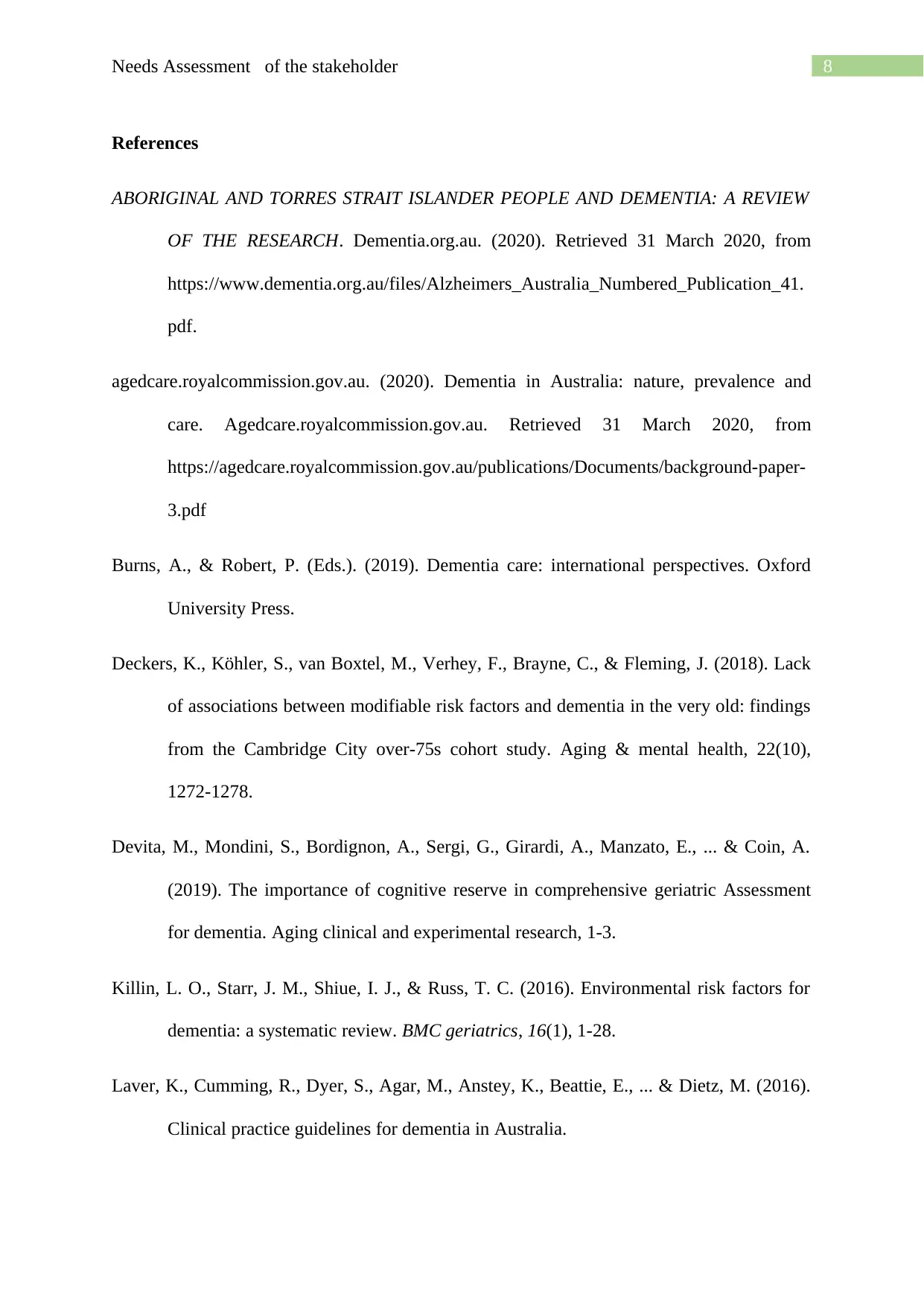
8Needs Assessment of the stakeholder
References
ABORIGINAL AND TORRES STRAIT ISLANDER PEOPLE AND DEMENTIA: A REVIEW
OF THE RESEARCH. Dementia.org.au. (2020). Retrieved 31 March 2020, from
https://www.dementia.org.au/files/Alzheimers_Australia_Numbered_Publication_41.
pdf.
agedcare.royalcommission.gov.au. (2020). Dementia in Australia: nature, prevalence and
care. Agedcare.royalcommission.gov.au. Retrieved 31 March 2020, from
https://agedcare.royalcommission.gov.au/publications/Documents/background-paper-
3.pdf
Burns, A., & Robert, P. (Eds.). (2019). Dementia care: international perspectives. Oxford
University Press.
Deckers, K., Köhler, S., van Boxtel, M., Verhey, F., Brayne, C., & Fleming, J. (2018). Lack
of associations between modifiable risk factors and dementia in the very old: findings
from the Cambridge City over-75s cohort study. Aging & mental health, 22(10),
1272-1278.
Devita, M., Mondini, S., Bordignon, A., Sergi, G., Girardi, A., Manzato, E., ... & Coin, A.
(2019). The importance of cognitive reserve in comprehensive geriatric Assessment
for dementia. Aging clinical and experimental research, 1-3.
Killin, L. O., Starr, J. M., Shiue, I. J., & Russ, T. C. (2016). Environmental risk factors for
dementia: a systematic review. BMC geriatrics, 16(1), 1-28.
Laver, K., Cumming, R., Dyer, S., Agar, M., Anstey, K., Beattie, E., ... & Dietz, M. (2016).
Clinical practice guidelines for dementia in Australia.
References
ABORIGINAL AND TORRES STRAIT ISLANDER PEOPLE AND DEMENTIA: A REVIEW
OF THE RESEARCH. Dementia.org.au. (2020). Retrieved 31 March 2020, from
https://www.dementia.org.au/files/Alzheimers_Australia_Numbered_Publication_41.
pdf.
agedcare.royalcommission.gov.au. (2020). Dementia in Australia: nature, prevalence and
care. Agedcare.royalcommission.gov.au. Retrieved 31 March 2020, from
https://agedcare.royalcommission.gov.au/publications/Documents/background-paper-
3.pdf
Burns, A., & Robert, P. (Eds.). (2019). Dementia care: international perspectives. Oxford
University Press.
Deckers, K., Köhler, S., van Boxtel, M., Verhey, F., Brayne, C., & Fleming, J. (2018). Lack
of associations between modifiable risk factors and dementia in the very old: findings
from the Cambridge City over-75s cohort study. Aging & mental health, 22(10),
1272-1278.
Devita, M., Mondini, S., Bordignon, A., Sergi, G., Girardi, A., Manzato, E., ... & Coin, A.
(2019). The importance of cognitive reserve in comprehensive geriatric Assessment
for dementia. Aging clinical and experimental research, 1-3.
Killin, L. O., Starr, J. M., Shiue, I. J., & Russ, T. C. (2016). Environmental risk factors for
dementia: a systematic review. BMC geriatrics, 16(1), 1-28.
Laver, K., Cumming, R., Dyer, S., Agar, M., Anstey, K., Beattie, E., ... & Dietz, M. (2016).
Clinical practice guidelines for dementia in Australia.
⊘ This is a preview!⊘
Do you want full access?
Subscribe today to unlock all pages.

Trusted by 1+ million students worldwide

9Needs Assessment of the stakeholder
Radford, K., Lavrencic, L. M., Delbaere, K., Draper, B., Cumming, R., Daylight, G., ... &
Hill, T. Y. (2019). Factors associated with the high prevalence of dementia in older
Aboriginal Australians. Journal of Alzheimer's Disease, 70(s1), S75-S85.
Sommer, I., Griebler, U., Kien, C., Auer, S., Klerings, I., Hammer, R., ... & Gartlehner, G.
(2017). Vitamin D deficiency as a risk factor for dementia: a systematic review and
meta-analysis. BMC geriatrics, 17(1), 16.
www.abs.gov.a. (2020). 3303.0 - Causes of Death, Australia, 2015. Abs.gov.au. Retrieved 31
March 2020, from https://www.abs.gov.au/ausstats/abs@.nsf/Lookup/by
%20Subject/3303.0~2015~Main%20Features~Dementia~10002.
www.aihw.gov.au. (2020). Dementia Overview - Australian Institute of Health and Welfare.
Australian Institute of Health and Welfare. Retrieved 31 March 2020, from
https://www.aihw.gov.au/reports-data/health-conditions-disability-deaths/dementia/
overview.
www.dementia.org.au. (2020). Dementia Australia National. Dementia.org.au. Retrieved 31
March 2020, from https://www.dementia.org.au/.
www.health.gov.au. (2020). National Framework for Action on Dementia 2015–2019.
Australian Government Department of Health. Retrieved 31 March 2020, from
https://www.health.gov.au/resources/publications/national-framework-for-action-on-
dementia-2015-2019.
www.health.gov.au. (2020). Working with dementia in aged care. Australian Government
Department of Health. Retrieved 31 March 2020, from
https://www.health.gov.au/health-topics/aged-care/providing-aged-care-services/
working-in-aged-care/working-with-dementia-in-aged-care.
Radford, K., Lavrencic, L. M., Delbaere, K., Draper, B., Cumming, R., Daylight, G., ... &
Hill, T. Y. (2019). Factors associated with the high prevalence of dementia in older
Aboriginal Australians. Journal of Alzheimer's Disease, 70(s1), S75-S85.
Sommer, I., Griebler, U., Kien, C., Auer, S., Klerings, I., Hammer, R., ... & Gartlehner, G.
(2017). Vitamin D deficiency as a risk factor for dementia: a systematic review and
meta-analysis. BMC geriatrics, 17(1), 16.
www.abs.gov.a. (2020). 3303.0 - Causes of Death, Australia, 2015. Abs.gov.au. Retrieved 31
March 2020, from https://www.abs.gov.au/ausstats/abs@.nsf/Lookup/by
%20Subject/3303.0~2015~Main%20Features~Dementia~10002.
www.aihw.gov.au. (2020). Dementia Overview - Australian Institute of Health and Welfare.
Australian Institute of Health and Welfare. Retrieved 31 March 2020, from
https://www.aihw.gov.au/reports-data/health-conditions-disability-deaths/dementia/
overview.
www.dementia.org.au. (2020). Dementia Australia National. Dementia.org.au. Retrieved 31
March 2020, from https://www.dementia.org.au/.
www.health.gov.au. (2020). National Framework for Action on Dementia 2015–2019.
Australian Government Department of Health. Retrieved 31 March 2020, from
https://www.health.gov.au/resources/publications/national-framework-for-action-on-
dementia-2015-2019.
www.health.gov.au. (2020). Working with dementia in aged care. Australian Government
Department of Health. Retrieved 31 March 2020, from
https://www.health.gov.au/health-topics/aged-care/providing-aged-care-services/
working-in-aged-care/working-with-dementia-in-aged-care.
1 out of 10
Related Documents
Your All-in-One AI-Powered Toolkit for Academic Success.
+13062052269
info@desklib.com
Available 24*7 on WhatsApp / Email
![[object Object]](/_next/static/media/star-bottom.7253800d.svg)
Unlock your academic potential
Copyright © 2020–2025 A2Z Services. All Rights Reserved. Developed and managed by ZUCOL.





